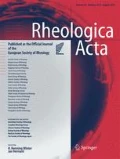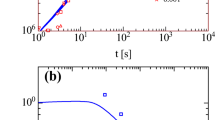Abstract
A consistent model of the rheology of polymer melts and concentrated solutions is presented, based on the idea that the pressures exerted by a polymer chain on the walls of an anisotropic confinement are anisotropic (Doi and Edwards. The Theory of Polymer Dynamics, Oxford University Press, 1986). In a tube model with variable tube diameter, chain stretch and tube diameter reduction are related, and at deformation rates larger than the inverse Rouse time τ R, the chain is stretched and its confining tube becomes increasingly anisotropic. Tube diameter reduction leads to an interchain pressure in the lateral direction of the tube (Marrucci and Ianniruberto. Macromolecules 37:3934-3942, 2004). Chain stretch is balanced by interchain tube pressure in the lateral direction, which is proportional to the third power of stretch, and by a spring force in the longitudinal direction of the tube, which is linear in stretch. Analyzing elongational viscosity data of Huang et al. (Macromolecules 46:5026-5035, 2013a; ACS Macro Letters 2:741-744, 2013b) shows that dilution of polystyrene by oligomeric styrene does not change the relative interchain tube pressure. Based on this extended interchain pressure concept, scaling relations for linear viscoelasticity and elongational viscosity of polystyrene melts and concentrated solutions of polystyrene in oligomeric styrene are presented based exclusively on the relaxation modulus of a reference polymer melt, the volume fraction of polymer in the solution, and the time-molar-mass shift as well as the time-temperature shift caused by the reduction of the glass transition temperature T g of the polymer in a solution relative to T g of the melt.









Similar content being viewed by others
References
Bach A, Almdal K, Rasmussen HK, Hassager O (2003) Elongational viscosity of narrow molar mass distribution polystyrene. Macromolecules 36:5174–5179
Baumgaertel M, Schausberger A, Winter HH (1990) The relaxation of polymers with linear flexible chains of uniform length. Rheol Acta 29:400–408
Doi M, Edwards SF (1986) The theory of polymer dynamics. Oxford University Press, Oxford
Fox TG, Flory PJ (1950) Second order transition temperatures and related properties of polystyrene. I. Influence of molecular weight. J Appl Phys 21:581–591
Hassager O (2004) Polymer fluid mechanics: Molecular orientation and stretching, Proc. XIVth Int. Congress on Rheology, NF01
Huang Q, Mednova O, Rasmussen HK, Alvarez, Skov AL, Almdal K, Hassager O (2013a) Concentrated Polymer Solutions are Different from Melts: Role of Entanglement Molecular Weight. Macromolecules 46:5026–5035
Huang Q, Alvarez NJ, Matsumiya Y, Rasmussen HK, Watanabe H, Hassager O (2013b) Extensional rheology of entangled polystyrene solutions suggests importance of nematic interactions. ACS Macro Lett 2:741–744
Isaki T, Takahashi M, Urakawa O (2003) Biaxial damping function of entangled monodisperse polystyrene melts: Comparison with the Mead-Larson-Doi model. J Rheol 47:1201–1210
Luap C, Muller C, Schweizer T, Venerus DC (2005) Simultaneous stress and birefringence measurements during uniaxial elongation of polystyrene melts with narrow molecular weight distribution. Rheol Acta 45:83–91
Ferry JD (1980) Viscoelastic properties of polymers. Wiley, New York
Marrucci G, Ianniruberto G (2004) Interchain pressure effect in extensional flows of entangled polymer melts. Macromolecules 37:3934–3942
Marrucci G, Ianniruberto G (2005) Modelling nonlinear polymer rheology is still challenging. Korea-Australia Rheol J 17(3):111–116
Menezes EV, Graessley WW (1982) Nonlinear rheological behavior of polymer systems for several shear-flow histories. Polym Phys 20:1817–1833
Nielsen JK, Rasmussen HK, Hassager O, McKinley GH (2006) Elongational viscosity of monodisperse and bidisperse polystyrene melts. J Rheol 50:453–476
Nielsen JK, Rasmussen HK, Hassager O (2008) Stress relaxation of narrow molar mass distribution polystyrene following uniaxial extension. J Rheol 52:885–899
Nielsen JK, Rasmussen HK (2008) Reversed extension flow. J Non-Newtonian Fluid Mech 155:15–19
Osaki K, Nishizawa K, Kurata M (1982) Material time constant characterizing the nonlinear viscoelasticity of entangled polymeric systems. Macromolecules 15:1068–1071
Rasmussen HK, Laille P, Yu K (2008) Large amplitude oscillatory elongational flow. Rheol Acta 47:97–103
Rasmussen HK, Huang Q (2014) The missing link between the extensional dynamics of polymer melts and solutions. J Non-Newtonian Fluid Mech 204:1–6
Rasmussen HK, Huang Q (2014) Interchain tube pressure effect in extensional flows of oligomer diluted nearly monodisperse polystyrene melts. Rheol Acta 53:199–208
Rolon-Garrido VH, Wagner MH, Luap C, Schweizer T (2006) Modeling non-gaussian extensibility effects in elongation of nearly monodisperse polystyrene melts. J Rheol 50:327–340
Takahashi M, Isaki T, Takigawa T, Masuda T (1993) Measurement of biaxial and uniaxial extensional flow behavior of polymer melts at constant strain rates. J Rheol 37:827–846
Wagner MH, Schaeffer J (1992) Nonlinear strain measures for general biaxial extension of polymer melts. J Rheol 36:1–26
Wagner MH, Schaeffer J (1993) Rubbers and Polymer melts: Universal aspects of non-linear stress-strain relations. J Rheol 37:28
Wagner MH, Schaeffer J (1994) Assessment of non-linear strain measures for extensional and shearing flows of polymer melts. Rheol Acta 33:506–516
Wagner MH, Rubio P, Bastian H (2001) The molecular stress function model for polydisperse and polymer melts with dissipative convective constraint release. J Rheol 45:1387–1412
Wagner MH, Kheirandish S, Hassager O (2005) Quantitative prediction of transient and steady-state elongational viscosity of nearly monodisperse polystyrene melts. J Rheol 49:1317–1327
Wagner MH, Rolon-Garrido VH, Nielsen JK, Rasmussen HK, Hassager O (2008) A constitutive analysis of transient and steady-state elongational viscosities of bidisperse polystyrene blends. J Rheol 52:67–86
Wagner MH, Rolon-Garrido VH (2009a) Recent advances in constitutive modeling of polymer melts. In: M. Zatloukal (ed) Novel Trends in Rheology III AIP Conference Proceedings 1152. American Institute of Physics, pp 16–31
Wagner MH, Rolon-Garrido VH (2009b) Nonlinear rheology of linear polymer melts: Modeling chain stretch by interchain tube pressure and Rouse time. Korea-Australia Rheol J 21:203–211
Wagner MH, Rolon-Garrido VH (2010) The interchain pressure effect in shear rheology. Rheol Acta 49:459471
Wagner MH (2011) The effect of dynamic tube dilation on chain stretch in nonlinear polymer. J Non-Newtonian Fluid Mech 166:194–915. ISSN 0377-0257. doi:10.1016/j.jnnfm.2011.04.006
Acknowledgments
Thanks are due to Qian Huang and Ole Hassager for sharing their experimental data. Financial support by the German Science Foundation is gratefully acknowledged.
Author information
Authors and Affiliations
Corresponding author
Rights and permissions
About this article
Cite this article
Wagner, M.H. Scaling relations for elongational flow of polystyrene melts and concentrated solutions of polystyrene in oligomeric styrene. Rheol Acta 53, 765–777 (2014). https://doi.org/10.1007/s00397-014-0791-1
Received:
Revised:
Accepted:
Published:
Issue Date:
DOI: https://doi.org/10.1007/s00397-014-0791-1




